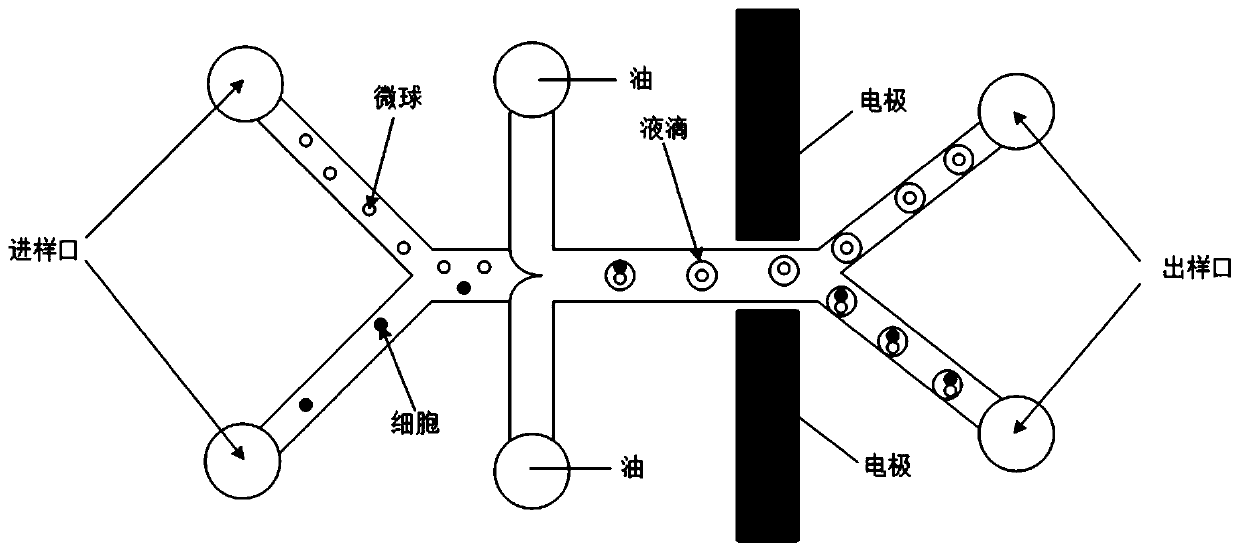Single cell sorting device and single cell sorting method
A single-cell and sorting technology, applied in the field of single-cell manipulation, which can solve problems such as low accuracy, affecting cell activity, and cell mechanical damage
- Summary
- Abstract
- Description
- Claims
- Application Information
AI Technical Summary
Problems solved by technology
Method used
Image
Examples
Embodiment 1
[0051] Embodiment 1 single cell sorting device
[0052] Such as figure 1 Shown is a schematic diagram of a single cell sorting device, which includes a microfluidic chip, an optical recognition unit, and an electrical sorting unit;
[0053] The microfluidic chip includes a sample inlet, a microfluidic channel and a sample outlet;
[0054] The sampling port includes a first sampling port and a second sampling port, and the first sampling port and the second sampling port are collected in a microfluidic channel;
[0055] The microfluidic channel is filled with an oil phase;
[0056] An optical recognition unit and an electrical sorting unit are sequentially arranged on the microfluidic channel;
[0057] The sample outlet is located downstream of the electrical separation unit;
[0058] The sample inlet is connected with a sample pump;
[0059] The optical recognition unit includes a camera;
[0060] The camera comprises a charge-coupled device camera or a complementary met...
Embodiment 2
[0066] Embodiment 2 single cell sorting device
[0067] The single cell sorting device includes a microfluidic chip, a charge-coupled device camera and electrodes;
[0068] The microfluidic chip includes a sample inlet, a microfluidic channel and a sample outlet;
[0069] The sample inlet includes a first sample inlet and a second sample inlet, which are located at the left end of the microfluidic chip, and are used to add cell suspension and microspheres to the microfluidic chip through an air pressure source and a sample pump. The first sample inlet and the second sample inlet are collected in the microfluidic channel;
[0070] The microfluidic channel is filled with an oil phase, placed between the optical lens objective lens and the eyepiece, and connected to a charge-coupled device camera;
[0071] Electrodes are arranged on both sides of the microfluidic channel, the voltage of the electrodes is ±100-±40000V, the width of the electrodes is 60-200μm, and the frequency o...
Embodiment 3
[0074] Example 3 single cell sorting method
[0075] Such as figure 2 Shown is the flow chart of the single-cell sorting method. Under the action of the sample pump, cell suspension and PS microspheres (particle size: 8~12μm), after the two are collected in the microfluidic channel, the cell suspension is mixed with the microspheres, and the microspheres can specifically capture single cells in the cell suspension;
[0076] After the microspheres with captured single cells are injected into the oil phase in the microfluidic channel, water-in-oil single-cell droplets containing single cells and microspheres are formed. The particle size of the single-cell droplets is 25-30 μm, and no Single-cell microspheres form water-in-oil microsphere droplets, and the particle size of the microsphere droplets is 15-20 μm;
[0077] The camera identifies single-cell droplets with larger particle sizes in the microfluidic channel, and uses image recognition algorithms to convert digital ima...
PUM
| Property | Measurement | Unit |
|---|---|---|
| Width | aaaaa | aaaaa |
| Particle size | aaaaa | aaaaa |
Abstract
Description
Claims
Application Information
 Login to View More
Login to View More - R&D
- Intellectual Property
- Life Sciences
- Materials
- Tech Scout
- Unparalleled Data Quality
- Higher Quality Content
- 60% Fewer Hallucinations
Browse by: Latest US Patents, China's latest patents, Technical Efficacy Thesaurus, Application Domain, Technology Topic, Popular Technical Reports.
© 2025 PatSnap. All rights reserved.Legal|Privacy policy|Modern Slavery Act Transparency Statement|Sitemap|About US| Contact US: help@patsnap.com


